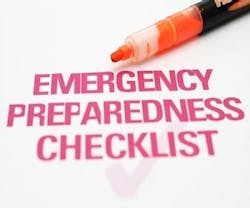Preparing for Common Workplace Emergencies
When it comes to common workplace emergencies, being prepared can go a long way toward protecting yourself and your employees. Is your facility prepared to handle a common disaster? Cintas Corporation has identified four commonplace emergencies that your staff should be ready to handle at a moment’s notice:
1) Fire. In 2009, structure fires caused more than $10.8 billion property damage and 2,695 civilian deaths. To combat a fire quickly and limit potential damage, employees need to know how to properly use a fire extinguisher. In addition, employees should understand the five classes of fire, when not to fight a fire and other potential fire prevention methods if a fire extinguisher is not available. Businesses should also be sure extinguishers are regularly serviced and inspected so they are ready for use in an emergency situation.
2) Chemical Spills. Chemical spills can happen anywhere, yet hazard communication violations are frequently cited as a top Occupational Health and Safety Administration (OSHA) violation.
Workers who use chemicals must have the proper training to understand the types of chemicals they’re using and proper classifications, including the FACTOR System (Flammable and Corrosive, Toxic or Reactive). In addition to understanding the right procedures for response, workers must have the proper equipment to respond to a chemical spill, including emergency eye wash stations and spill kits.
3) Sudden Cardiac Arrest. OSHA reports that there are 220,000 victims of sudden cardiac arrest (SCA) per year in the United States, and about 10,000 SCA episodes occur at work. To help reduce the opportunity of death surrounding a SCA incident, businesses should have an Automated External Defibrillators (AEDs) program in place, ensuring AEDs are accessible throughout common areas in the facility.
4) Blood Spills. In cases of severe lacerations or injuries, businesses should have a protocol in place for cleaning up blood. With heightened awareness of potential exposure to bloodborne disease, it is important that staff members know how to properly cleanup blood and limit the risk for infection or disease.
These glances at common disasters and emergencies are not comprehensive by any means, but they are an excellent place to start when looking to prepare your facility for unexpected situations.
